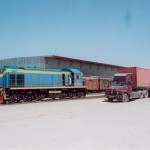
Asian Development Bank announces that a memorandum has been signed highlighting the importance of developing a railway line
to Mazar-i-Sharif and Herat from the current Uzbekistan railways railhead at Hairatan. The Afghan government has requested technical and financial assistance
from ADB for a pre-feasibility study.
It was recently reported by Der Spiegel that the German military is allegedly interested in building a long-planned railway extension from Hayratan to Mazar-i-Sharif. Meanwhile, Herat will be the terminus of a line currently being built from Iran, offering the possibility of an Uzbekistan to Iran route; Uzbekistan and Iran also recently signed co-operation agreements.
In the past railway proposals for Afghanistan seem to have focused on the south of the country, with international lines to Pakistan, but current plans seem to be oriented north and west.
The gauge question will presumably rear its head with any Uzbekistan – Iran link, as the Iranian line will be standard gauge (1435 mm), but the existing line from Uzbekistan to Hayratan is 1520 mm broad gauge. Putting the break-of-gauge in Herat could be the obvious answer?
Uzbekistan and Afghanistan have also agreed Rules for Passenger Transport & Freight Accounts for the Uzbekistan-Afghanistan Railway. The reference to passengers is interesting, as I’ve not heard of Afghanistan having a passenger service since the demise of the Kabul to Darulaman steam line. Perhaps cross-border passenger services are planned – or maybe it is just a formallity, and they thought they may as well include passengers when working out the details of freight transport?
BAKU, AZERBAIJAN – Uzbekistan, Afghanistan, and the Asian Development Bank (ADB) have signed a Memorandum of Understanding (MOU) to expand trade and economic opportunities through railway transport.
The MOU, signed on the eve of the Seventh annual Central Asia Regional Economic Cooperation (CAREC) Ministers’ Conference in the Azerbaijan capital, recognizes the potential for growth in railway freight traffic, including transit freight traffic, between Uzbekistan and Afghanistan.
“With the MOU, we will be taking a major step toward realizing the dream of expanded trade and economic opportunities for larger Central Asia,” said Mr Zhao Xiaoyu, ADB Vice-President (Operations 2). Afghanistan Minister of Finance, Dr Anwar-Ul-Haq Ahady and Uzbekistan Minister for Foreign Economic Relations, Investment and Trade, Mr Elyor Ganiev signed on behalf of their governments.
With the MOU, the Afghanistan Government underlined the importance of developing a railway line between the Afghan cities of Hairatan which borders Uzbekistan through Mazar-e-Sharif and Herat. The Afghanistan Government has requested technical and financial assistance from ADB in order to prepare a pre-feasibility study for the proposed railway project. Uzbekistan will give its full cooperation in the conduct of the study.
A Project Working Group, comprising representatives from both countries will supervise the study and explore other regional cooperation initiatives between Uzbekistan and Afghanistan in the field of transport and trade facilitation.
Transport sector development is vital for sustained growth and poverty reduction in this landlocked region and railways are a critical part of the transport sector in the region.
In support of the initiative, Uzbekistan and Afghanistan recently signed the Uzbekistan-Afghanistan Boundary Railway Agreement; the Freight Transportation Rules for the Uzbekistan-Afghanistan Railway; and Rules for Passenger Transport and Freight Accounts for the Uzbekistan-Afghanistan Railway.
The Asian Development Bank is a multilateral development bank, owned by 67 member countries. ADB’s main instruments for developing its member countries are policy dialogue, loans, equity investments, guarantees, grants and technical assistance. This year ADB adopted Strategy 2020, a long-term strategic framework that follows three complementary strategic agendas: inclusive growth, environmentally sustainable growth, and regional integration.
Further information about the ADB and CAREC can be found at http://www.adb.org/carec
Source: Asian Development Bank news release 20 November 2008
